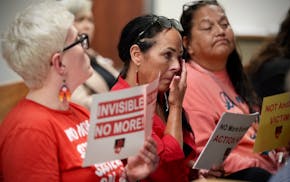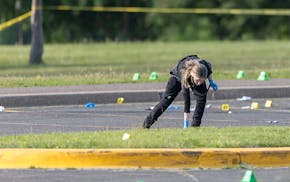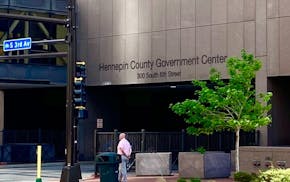Fifty years after the fall of Saigon, five artists from the Vietnamese diaspora are transforming St. Paul's Xia Gallery and Cafe into a space blurring the lines between an exhibition and a site of mourning, memory and imagined return.
Through five video, photography, sculpture and mixed-media installations, "Re/Homing: Walk-ins Welcome," confronts the instability of "home" for refugees.
Curated by Christina Hughes, an assistant professor at Macalester College, the show opened May 3 amid heightened border enforcement and deportations to reckon with what has been neglected, and to consider the many ways diasporic communities build lives and create belonging in the U.S.
"Walk-ins Welcome" is a common phrase seen in nail salons tied to Vietnamese American labor and entrepreneurship. But here, the artists ask: Who is welcomed, and under what conditions?
The free exhibit, which is on display through May 31, is open 10 a.m. to 3 p.m. Saturdays and Sundays.
Hughes' family arrived as part of the first wave of Vietnamese refugees after the fall of Saigon (the former capital of South Vietnam, now Ho Chi Minh City). Her father, once a chemist, ended up driving trucks and working in a nail salon. Her mother, caught up in a financial web, was incarcerated in a federal prison.
These experiences inform Hughes' academic work on "refugee racial capitalism," a term that builds on Black radical thought to describe how refugees are funneled into low-wage labor, fueling the economy while being denied adequate state support.
"Refugees are really offered two paths when they get here: one is to assimilate into a model minority subjectivity and the other is to labor under welfare conditions that make them work while also keeping them in a cycle of poverty," she said. "Those are the people that oftentimes get incarcerated, over-policed and are now made deportable under this administration."
Hughes' installation features a prison visitation booth constructed from cinder blocks and covered in crochet granny squares, a skill her mother taught her while incarcerated. The work reflects what Hughes describes as "alternative infrastructures of community care."
The exhibit then leads into the "Bureaucratic Checkpoint," a mixed-media installation by N. Bui. The artist thinned rau muống (water spinach), a staple in Vietnamese dishes, into sheets of handmade paper to explore how living things are flattened into objects of state control.
The cultivation of water spinach became more common in the U.S. after the arrival of Vietnamese and Southeast Asian refugees in the 1970s, which led to increased government regulation. In several states, the plant is considered an invasive species, making it illegal to import and transport between states without a permit.
"It's a contemplation on the regulation that this plant is experiencing," Hughes said. "It's being placed analogously to the regulation of human movements across borders."
Documentary filmmaker Quyen Nguyễn-Lê, who uses they/them pronouns, presents a reimagined mobile nail salon to honor their mother's business, which closed suddenly during the COVID-19 pandemic. The installation reflects on the cultural role of salons in the Vietnamese refugee community and Nguyễn-Lê's own childhood memories of growing up queer within that space — observing, but not always feeling like they belonged.
"I think when you're in the diaspora, there's this kind of heaviness around passing on the culture, like 'Do your kids know Vietnamese?'" Nguyễn-Lê said. "When you're queer, you're totally out of the conception of what people expect, which is both liberating and sad. Liberating in the sense that you're free because no one can define you … sad because, in many ways, your family forgets about you."
Artist Ly T. Nguyen, born in Vietnam and now teaching Asian American Studies at Augsburg University, presents a sculptural and video installation that weaves together her matrilineal lineage.
One piece features hands, evoking an intimate memory of massaging her grandmother's paralyzed fingers that were worn down by decades of labor. A video documents Nguyen shaving her own head, using the hair to build a family tree that resists patriarchal norms in Vietnam, where women are often written out of ancestral histories.
Artist Nhung Walsh's audio installation works with a year-long collection of interview recordings from a survivor of the 1968 Mỹ Lai massacre, where more than 400 Vietnamese civilians were killed by U.S. soldiers.
The survivor, once a child in the village, later became a state-recruited voice, traveling from community to community in Vietnam, reciting his testimony as part of a national campaign to mobilize resistance against U.S. military presence. Over time, Walsh observed, the repeated telling of this traumatic story began to hollow it out — turning lived memory into something external, rehearsed and distant.
Rather than present the survivor's words, Walsh focuses on the gaps of silence between phrases and sentences in the archive of recorded testimonies. Her final piece is an audio file composed almost entirely of those silences.
About the partnership
This story comes to you from Sahan Journal, a nonprofit newsroom dedicated to covering Minnesota's immigrants and communities of color. Sign up for a free newsletter to receive Sahan's stories in your inbox.

'Red alert': Researchers say Minneapolis is failing in response to domestic violence calls

After barrage of gunfire, neighbors, city officials take critical look at Boom Island Park safety

Bushel Boy, Minnesota's local tomato grower, sold
Federal agents surround south Minneapolis restaurant, clashing with protesters

